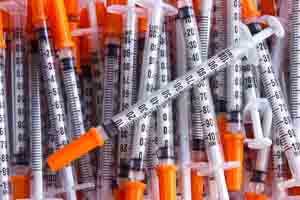 Insulin syringes or needles are one thing people would rather not think about. After all, I am not aware of anyone who actually likes to be injected with anything, least of all insulin on a daily basis. This distaste raises a number of important issues, however.
Insulin syringes or needles are one thing people would rather not think about. After all, I am not aware of anyone who actually likes to be injected with anything, least of all insulin on a daily basis. This distaste raises a number of important issues, however.
What needles most commonly used? Is there any other choices? Do some syringe choices hurt less than others?
Before we get started, please be aware that you will need to consult with your health care provider to choose the best insulin needle for you. Some of the decision is comfort based, but much of it is medically driven, so talk to your doctor.
Let’s take a look at the insulin needle landscape to see where we are, and maybe where we are going.
The Basics
Using syringes to inject insulin is arguably the most common method of delivery. There are many reasons, including:
- Least Expensive Option (compare an insulin pump price!)
- Readily Available (All pharmacies carry them)
- Usually Covered by Insurance
- Ease of Use
But how do you choose? Let’s start with some basic vocabulary. To understand your choices, you really need to understand the terminology that is used to describe the different needles or syringes.
Needle Size. This is the overall shape of the needle. Two components are important, the gauge and the length.
Gauge. The needle gauge refers to the thickness of the needle. The typical thickness ranges from 25 to 31, although other options can be available. The higher the number is the THINNER the needle.
Needle Length. Lengths are usually either 1/2 inch (often called normal or long) or 5/16 inch (often called short).
Syringe Capacity. This term refers to the amount of insulin a syringe or needle can hold. Usually, your options are either 1 mL, 1/2 mL, or 3/10 mL. The capacity of your syringe will depend on how much insulin you are taking. For example, if you take 30 units of insulin you would most likely use a 30 mL capacity syringe.
However, be aware that many syringes come in 1/2 unit and whole unit measurements printed on the side to make loading the syringe easy and accurate.
U-100 or U-40. As you go shopping for your syringes, you may also notice the term U-100 and U-40 (there are others as well) in the product description. These terms refer to the amount of insulin in each mL of solution. For example, U-100 has 100 units of insulin in each mL of solution. Thus, the syringe capacity is important. If you use U-40 insulin in a U-100 syringe (and vice versa), you will have to do a conversion calculation. U-100 is the most common concentration in the United States.
How to Choose the Right Syringe
 As discussed above, step one is to talk with your doctor. Depending upon your situation, he or she will most likely have a recommendation.
As discussed above, step one is to talk with your doctor. Depending upon your situation, he or she will most likely have a recommendation.
Also, depending upon certain individual characteristics such as the thickness of your skin, the amount of fatty tissue you have and general absorption issues (how well you absorb insulin), there may be medical reasons for going with one needle or another.
However, you probably do have some choices, particularly with the length and gauge. Interestingly, some people find a longer needle (1/2 inch) actually is less painful than a shorter needle. Some find the opposite is true.
Also, some find a thicker needle is better than a thinner needle (gauge). Again, some find the opposite is true.
The bottom line is that most people have a choice in regards to the thickness and length of their insulin syringes. However, you will probably need to do some experimentation to find the right choice for you.
By Erich Schultz – Last Reviewed March 2013.
